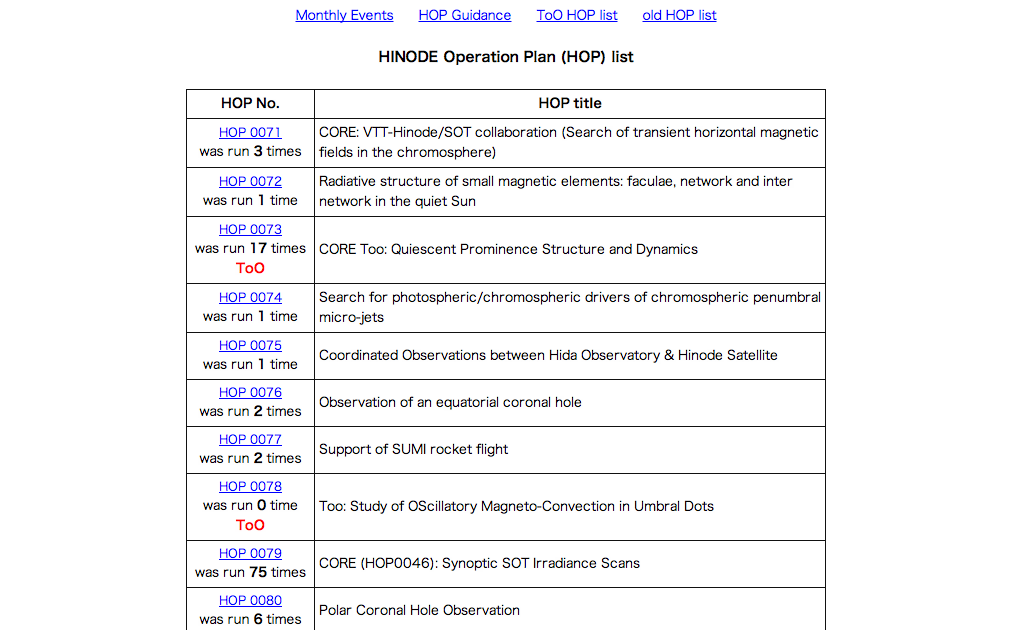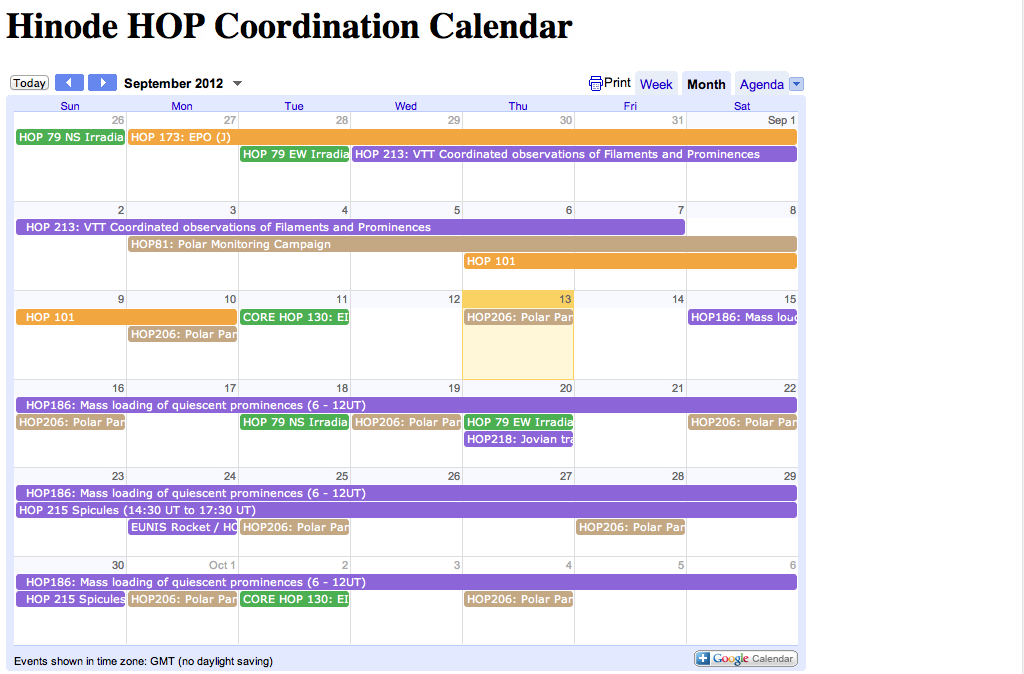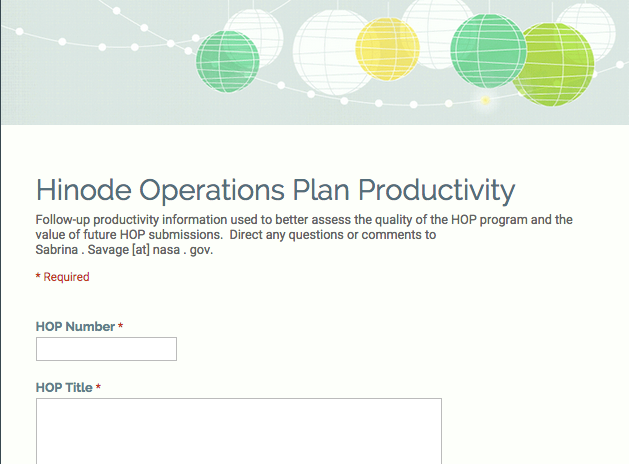National Aeronautics and Space Administration
Marshall Space Flight Center
Hinode Operation Plans (HOPs)
Information needed for proposal development outlined below.
Also refer to http://www.isas.jaxa.jp/home/solar/guidance/index.html as the lead reference.
After reviewing the material, **SUBMIT A HOP
PROPOSAL HERE**.
Helpful Planning Guide Summary
Post-Submission Productivity Updates
Contents
Information Required in Submitted Proposals
Information about the Hinode Instruments
Encouraged Observations from All Proposers
Prioritization of Flare observations for Hinode: (updated on December 20, 2011)
Prioritization of IRIS-Hinode Operations Plans (IHOPs) (updated on June 18, 2015)
IRIS/Hinode support for ALMA cycle 4 observations
Guideline for Hinode Scientific Operations
Deadline for Submission
Planning for Hinode operations is performed on a three month cycle that is updated monthly. At the end of every month a monthly meeting is held to confirm the observations for the coming month and to lay out the broad objectives for the second and third months.
The cut-off for consideration is the 14th day of each month. For example, requests for observations received between the 15th of June and the 14th of July will be presented and discussed at the monthly meeting held at the end of July.
It is recommended that proposers make their submissions as early as possible, so that the Science Schedule Coordinators (SSCs) have time to refine the proposals to fit the current Hinode situation.
Late submissions may be considered only exceptionally, if scheduling conflicts can be easily resolved in the operation planning meetings.
Information Required in Submitted Proposals
- Title of the proposed observation.
- Short statement describing the observation, and scientific
justification.
- This should be as short and concise as possible, but it should still contain all the key details. This statement is important because Hinode's limited data volume situation may make it necessary to modify some planned observations on some days. The Hinode team will refer to this statement when setting priorities for which observations to perform.
- Point of contact. Name and email address.
- Time period of proposed observations, if required.
- Provide the start and end dates with the reason.
- Provide the minimum number of observation days during the period.
- Provide desires and requirements for continuity of observations, for example: "three consecutive days are desired, but not required," "three consecutive days are required," or "it is not necessary for observations to be on consecutive days."
- Time window in day, if required.
- Provide the "minimum" duration with the start and end times in UT, if it is a coordinated observation with ground-based or space-based observatories.
- Specify whether any short interruptions (e.g., for ten-minute synoptics) are allowed over the observing periods.
- Target of interest.
- Clearly specify the target of interest.
- Active region, quiet Sun, on-disk, near limb, limb, polar region, etc.
- More specific description of the target, if required.
- Indicate whether it is a target of opportunity (TOO). If so, suitably describe the target.
- If a suitable target does not exist during the specified period, we may not perform the proposed observation during that period.
- Clearly specify the target of interest.
- Required Hinode instruments, and priority of observables.
- The Hinode team will take into account the stated priorities if it is necessary to make adjustments to the proposed observations to fit in the day's available telemetry, etc.
- Specify which Hinode instruments are really required for the observation.
- Specify required observables (cadence, FOV vs pixel summation,
wavelengths etc), with priorities, for the primary required Hinode
instrument(s).
- Provide rough estimate of the total data volume to be collected, if possible. See section 3 for estimating the total data collected.
- If support from non-primary Hinode instrument(s) is also desired, give a rough idea regarding preferable observables (cadence, FOV vs pixel summation, wavelengths etc).
- For IHOPs (IRIS/Hinode Operations Plans), specify the requirements for the IRIS observations, ideally with:
- an IRIS OBS-ID (for details see https://www.lmsal.com/iris_science/doc?cmd=dcur&proj_num=IS0301&file_type=pdf)
- alternatively, requirements for IRIS FOV, raster mode, raster cadence/exposure time, summing, slit-jaw choices
- List of past HOPs in which the present proposer was the PI, and the publications out of those HOPs.
Information about the Hinode Instruments and IRIS

Encouraged Observations from All Proposers
- Coordinated observations with ground-based facilities and space-borne instruments, if the period/time specification is critical.
- Coordination among more than two Hinode instuments if there is a critical time constraint to the observations, or if both instruments are required to consume significant telemetry resources.
- Observations requiring telemetry volumes which are a large percentage of the regular allocations of the instruments.
- Coordination with IRIS (through an IHOP)
- Observations designed for Focused Mode Operations (i.e., active region evolution, wave studies, quiet sun studies)
Flare Prioritization
Prioritization of Flare observations for Hinode: (updated on December 20, 2011)
The Hinode SWG has reviewed the processes and procedures for flare observations based on the issuance of a Max Millennium Flare Watch (MMFW) as well as the productivity of Hinode Observation Programs
(HOPs). The SWG has made two decisions regarding these observing programs.
First, regions with the potential to create flare will be given the highest observing priority. The target for the observations may utilize the MMFW target designation or Hinode will begin instituting a “Hinode Flare Watch” that may be called by the Chief Planner, Toshi Shimizu, Taro Sakao, or a designate of the Science Schedule Committee. The target for the Hinode Flare watch will be selected at that time, and the instruments will follow that target using approved flare watch programs. Any HOPs not completed as the result of a flare watch will be rescheduled, if possible, and the contact for the HOP will be notified of the change in plan as soon as possible after the issuance of the Hinode Flare watch. Synoptic observations (including synoptic HOPs) should be completed as scheduled or as soon as possible after the end of the flare watch. The SWG will assess success of this new policy at the August 2012 SWG meeting.
The productivity of many of the HOPs in terms of papers published from the observations is much lower than the data collected during Hinode standard observations that are generated by the instrument
team members. To better utilize the limited data volume, in accordance with the second decision of the SWG, the weekly data volume allocations will change from roughly 50% HOPs and 50% instrument team
observations. The new allocation will be 75% decided by the instrument team or daily planning meeting consensus and 25% SSC scheduled HOPs. The SSC is granted the option of changing this allocation,
as circumstances require.
IHOP Prioritization
Prioritization of IRIS-Hinode Operations Plans (IHOPs)
The Hinode SWG has decided to prioritize and encourages proposals for so-called IRIS/Hinode Operations Plans (IHOPs). Requests and details of these operations plans are similar to normal HOPs except that they include requests for observations from the Interface Region Imaging Spectrograph (IRIS). IRIS is a small explorer satellite, built and operated for NASA by Lockheed Martin Solar & Astrophysics Laboratory in Palo Alto, CA. IRIS takes both images and spectra of the solar photosphere, chromosphere, transition region and corona at high spatial, temporal and spectral resolution, providing datasets that are highly compatible with Hinode's suite of instruments. Details on IRIS observing capabilities and what needs to be included for IRIS in IHOPs can be found here:
https://www.lmsal.com/iris_science/doc?cmd=dcur&proj_num=IS0301&file_type=pdf.
Coordination with IRIS, through IHOPs, will be performed throughout the year, but will be very high priority during the months of February, March, April as well as August, September and October since neither IRIS or Hinode are in eclipse season during these months.
IHOPs will be discussed at the monthly meeting, just like HOPs.
IRIS/Hinode support for ALMA cycle 4 observations
Coordination with ALMA observations of the Sun is high priority for both the IRIS and Hinode missions. IRIS and Hinode provide observations from the photosphere to the corona that are ideal complements to the chromospheric measurements with ALMA. During the upcoming ALMA cycle 4 solar observations from December 2016 to April 2017, IRIS and Hinode will prioritize support of successful ALMA cycle 4 solar observing proposals. Proposers to the ALMA cycle 4 can refer to this message as evidence of IRIS/Hinode support for their observations.We suggest that PIs of accepted ALMA proposals inform the Hinode and IRIS teams as soon as possible of the desired observational support -- our teams will be happy to collaborate with you to tailor the coordinated observations to your science goals. We suggest that successful ALMA proposers submit a request for an IHOP (IRIS-Hinode Operations Plan), see http://hinode.msfc.nasa.gov/hops.html#requirements for details. Please use the Submission Form.
Please keep in mind that while IRIS is in eclipse season from early November through mid February, during this time frame IRIS will nevertheless be able to provide high quality observations for about 60 minutes out of every orbit (97 minutes). To maximize overlap with IRIS, requesting at least 1.5 hours of ALMA observations is the best option. IRIS has no limitations for ALMA support from mid February onwards.
As the observation date nears, close communication on the timings and pointings of the ALMA observations will be required in order to allow Hinode and IRIS to coordinate successfully.
If you have questions about support for ALMA observations, please contact Sabrina Savage for Hinode (sabrina dot savage at nasa dot gov) and Bart De Pontieu for IRIS (bdp at lmsal dot com).
Guideline for Hinode Scientific Operations
- Coordination among the proposal observations (HOP), core program observations, and instrument-required engineering activities, is crucial in obtaining valuable scientific data from daily observations.
- An ideal goal in scheduling is that the resource allocated for the proposal (HOP) observations is well balanced with that for core team program observations i.e. 50% core: 50% non-core. However, depending on the nature of observations, the solar activity condition and available telemetry, this ground rule is always interpreted with flexibility. For example in a typical case, two days could be fully assigned to a core program and the next two days to a HOP observation.
- The final decision for scheduling of observations will to be made in the daily operation planning meetings (1:30 UT, Mon - Sat) through discussions among the Chief Planner (CP), Chief Observers (CO), and core operation team personnel and for IHOPs, with the IRIS team. Programme planning decisions made in these meetings are final.
- The daily data allocation can vary in unexpected ways, due to unforeseen circumstances e.g. uncertainty in compression efficiency. Also, it is sometimes necessary for one or more instruments to carry out high-priority test or engineering studies at short notice. Because the telemetry resources are limited, this means that the scheduled HOPs may have to be canceled or postponed without warning on certain days. The Hinode team will make every effort to avoid cancellations.
- When suitable solar conditions arise for a TOO study, the Hinode team may allocate more resources to such observations, rather than carrying out the scheduled HOP(s).
- It may not be possible to perform more than one or two HOPs in the same day, depending on the total data collected, internal Hinode team plans, etc. In such cases, the Hinode team may give higher priority to one HOP over others. Such determinations will be made in the monthly (once per month), weekly (on Fri), and/or daily meetings.
- As much as possible, the Hinode team will try to find scheduling solutions that result in all the Hinode instruments performing their observations simultaneously, in order to maximize scientific output. This coordination will be arranged in the weekly and daily meetings with best efforts of CP and COs.
- The scheduling procedure and HOP-planning procedure may be modified according to further experience. This document will be updated to reflect such modifications.
- Coordination with IRIS, through IHOPs, will be performed throughout the year, but will be very high priority during the months of February, March, April as well as August, September and October since neither IRIS or Hinode are in eclipse season during these months.
Hinode Ground-based coordination protocol

New Policies
New policy regarding major flare watches, target of opportunity HOPs, and synoptic/long-term study HOPs (updated on July 31, 2010)
In their last two monthly meetings, the Hinode Science Schedule
Coordinators and PI's have decided that all HOP support will be
suspended in the event of a "Major Flare Watch" being issued by the
Max Millenium Flare watch web site. If a major flare watch is called,
any HOP scheduled for support during the period of the flare watch
will be rescheduled. The target for Hinode will be the Active Region
identified for the flare watch, and the observing programs will be the
core Hinode flare observations, and the Hinode instruments will be
operated with the baseline flare programs listed on the website:
http://www.isas.jaxa.jp/home/solar/hinode_op/flare_observation/Hinode_AR_FL_obs_plan.htm
Note that details of the baseline programs are subjects to change
without notice. Alternate programs may be directed by the PI's of the
instruments. Normal HOP support will resume when the flare watch has
expired.
The Chief Planner and Chief Observers may also suspend normal HOP support if a sufficiently interesting target of opportunity (TOO) for an identified TOO HOP appears. Such targets might be a flaring active region that does not quite meet the standards for a major flare alert, a newly emerging active region, a large filament or prominence, etc. Factors to be considered in making this decision in the daily meeting include: uniqueness and priority of the normally scheduled observations, frequency of occurrence of similar TOOs, weather and seeing conditions at ground based observatories, availability of telemetry, length of time the TOO HOP has been waiting to be run, etc. When this decision is made, the COs should explain the reasons for the changes in their daily plan announcements and should refer questions about the plan to the SSCs and PIs.
Hinode also runs long term synoptic HOPs at regular intervals, such as HOPs 79, 81, 131, and 146. These HOPs may need to be rescheduled in the event of a major flare watch or other active sun conditions. HOP 79 has been updated to reflect with what "frequency" the HOP should be run and how flare watches and schedule conflicts can be addressed. HOP 81 also can be rescheduled by +/- 2-3 days to accommodate active region and flare studies. The Chief Planner and Chief Observers should refer to all the HOP descriptions for guidance on how to accommodate active sun conditions.
Remarks
Old HOPs accepted before June 2008 (older than HOP71) are no longer valid. Proposers are requested to re-submit their revised HOP proposals to the SSCs, taking into account the limited telemetry resources.
Points of Contact
- Chief Coordinators
Sabrina Savage (sabrina.savage (at) nasa.gov)
Tetsuya Watanabe (watanabe (at) uvlab.mtk.nao.ac.jp) - Scientific Schedule Coordinators - Instrument Specific
- Solar Optical Telescope (SOT)
Dick Shine (shine (at) lmsal.com)
Takashi Sekii (sekii (at) solar.mtk.nao.ac.jp) - X-Ray Telescope (XRT)
Leon Golub (golub (at) head.cfa.harvard.edu)
Taro Sakao (sakao.taro (at) isas.jaxa.jp) - EUV Imaging Spectrometer (EIS)
Len Culhane (j.culhane (at) ucl.ac.uk )
Tetsuya Watanabe (watanabe (at) uvlab.mtk.nao.ac.jp )
John Mariska (jtmariska (at) gmail.com )
- Solar Optical Telescope (SOT)
- For IHOPs (i.e., HOPs that include IRIS requests), please send the IHOP draft also to IRIS science lead Bart De Pontieu (bdp (at) lmsal.com)
- NASA Contact: Adam Kobelski
- Page Last Updated: Wednesday, 15 November 2017






